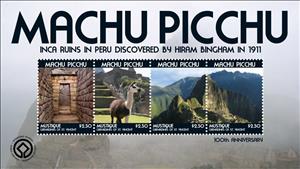Mini Sheet: 100th Anniversary of the Discovery of Machu Picchu (Grenadines of St. Vincent, Mustique 2011)
100th Anniversary of the Discovery of Machu Picchu (Grenadines of St. Vincent, Mustique 2011)
18 March (Grenadines of St. Vincent, Mustique ) within release 100th Anniversary of the Discovery of Machu Picchu goes into circulation Mini Sheet 100th Anniversary of the Discovery of Machu Picchu face value 4*2.50 East Caribbean dollar
| Mini Sheet 100th Anniversary of the Discovery of Machu Picchu in catalogues | |
|---|---|
| Michel: | Mi: VC-MU 157-160KB |
Mini Sheet is square format.
Also in the issue 100th Anniversary of the Discovery of Machu Picchu:
- Mini Sheet - 100th Anniversary of the Discovery of Machu Picchu face value 4*2.50;
- Stamp - Machu Picchu face value 2.50;
- Stamp - Machu Picchu face value 2.50;
- Stamp - Machu Picchu face value 2.50;
- Stamp - Machu Picchu face value 2.50;
Mini Sheet 100th Anniversary of the Discovery of Machu Picchu it reflects the thematic directions:
Animals are multicellular, eukaryotic organisms of the kingdom Animalia (also called Metazoa). All animals are motile, meaning they can move spontaneously and independently, at some point in their lives. Their body plan eventually becomes fixed as they develop, although some undergo a process of metamorphosis later on in their lives. All animals are heterotrophs: they must ingest other organisms or their products for sustenance.
Archaeology or archeology[a] is the study of human activity through the recovery and analysis of material culture. The archaeological record consists of artifacts, architecture, biofacts or ecofacts, sites, and cultural landscapes. Archaeology can be considered both a social science and a branch of the humanities. It is usually considered an independent academic discipline, but may also be classified as part of anthropology (in North America – the four-field approach), history or geography
A landscape is the visible features of an area of land, its landforms and how they integrate with natural or man-made features. A landscape includes the physical elements of geophysically defined landforms such as (ice-capped) mountains, hills, water bodies such as rivers, lakes, ponds and the sea, living elements of land cover including indigenous vegetation, human elements including different forms of land use, buildings and structures, and transitory elements such as lighting and weather conditions. Combining both their physical origins and the cultural overlay of human presence, often created over millennia, landscapes reflect a living synthesis of people and place that is vital to local and national identity. The character of a landscape helps define the self-image of the people who inhabit it and a sense of place that differentiates one region from other regions. It is the dynamic backdrop to people’s lives. Landscape can be as varied as farmland, a landscape park, or wilderness. The earth has a vast range of landscapes, including the icy landscapes of polar regions, mountainous landscapes, vast arid desert landscapes, islands and coastal landscapes, densely forested or wooded landscapes including past boreal forests and tropical rainforests, and agricultural landscapes of temperate and tropical regions.
A temple (from the Latin word templum) is a building reserved for religious or spiritual rituals and activities such as prayer and sacrifice. It is typically used for such buildings belonging to all faiths where a more specific term such as church, mosque or synagogue is not generally used in English. These include Hinduism, Buddhism, and Jainism among religions with many modern followers, as well as other ancient religions such as Ancient Egyptian religion.




